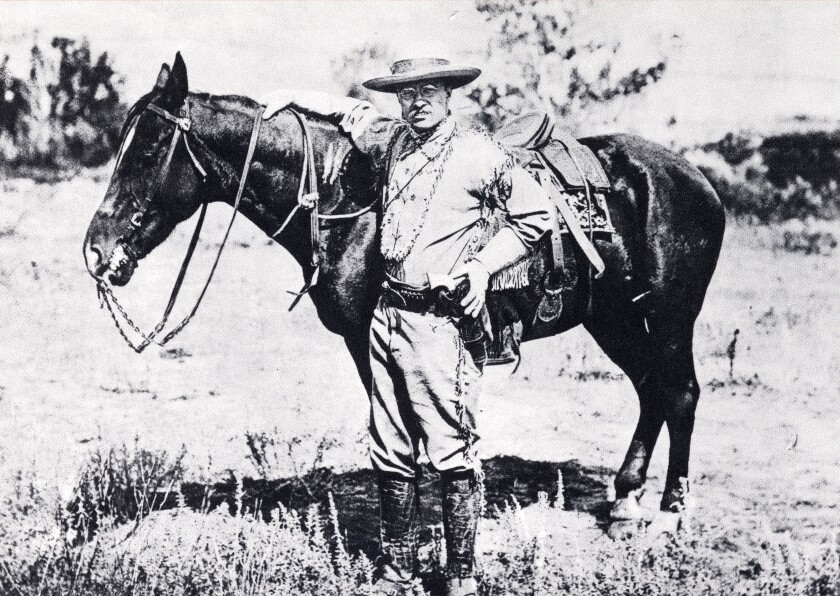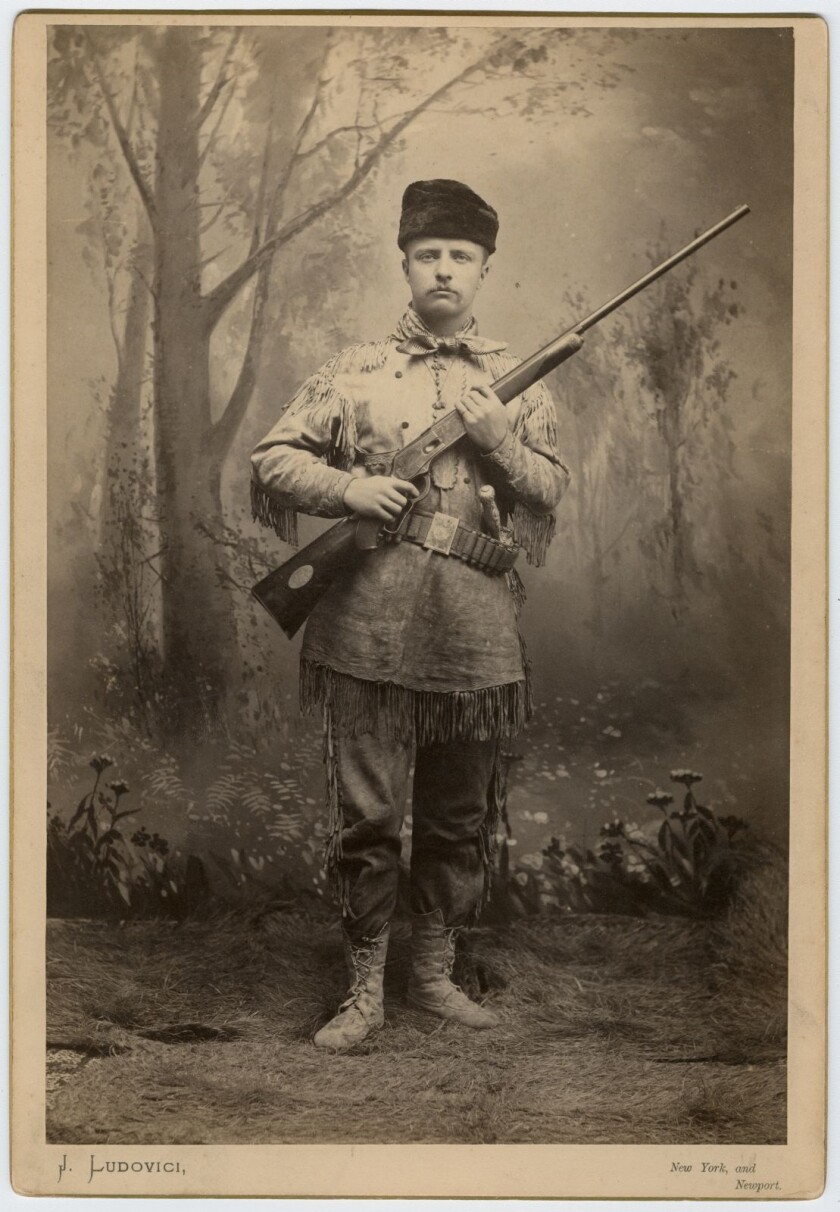MEDORA, N.D. — Accounts of the famous story of Theodore Roosevelt’s pilgrimage to North Dakota’s Little Missouri Badlands to shoot a buffalo before they became extinct often omit an important detail.
Roosevelt intentionally sought to shoot a “Lonesome George,” an old bull separated from the herd that was past his breeding years and therefore no longer important to perpetuating the species.
The historian Douglas Brinkley noted the conservation-minded goal of Roosevelt’s famous buffalo hunt while also critically examining his “trigger-happy” determination to bag large numbers of trophy animals during his time ranching and hunting in the Badlands in the 1880s.
Brinkley, who wrote about those contradictory impulses in “The Wilderness Warrior: Theodore Roosevelt and the Crusade for America,” is spending the summer in Medora to give talks, book signings and interpretive hikes about Roosevelt in the Badlands.
Was Roosevelt’s professed goal of bagging an old bull buffalo sincere, or was it for appearances?
ADVERTISEMENT
“I think it was genuine,” Brinkley said, a view that is supported by Roosevelt’s later accomplishments as the “conservationist president.”

He’s the inaugural historian in residence for the Theodore Roosevelt Presidential Library under development in Medora, a project that will be at least $100 million with the goal of being finished in 2025.
Brinkley is no stranger to Medora and Roosevelt’s former Badlands stamping grounds. His first visit to the area was in 1992, when he led a college class on a learning trip that included a stop at Theodore Roosevelt National Park; he was the guest of Harold and Shyla Schafer.
“We would do a sort of full-bore Medora experience,” he said. Brinkley, who is the Katherine Tsanoff Brown professor in humanities at Rice University in Houston, developed his habit of visiting historical sites in childhood. His teacher parents loaded up the Pontiac and towed a Coachman trailer to national parks around the country.
“Getting out there in the topography of America and seeing where history unfolded is a passion,” he said.
Important conservation history unfolded during Roosevelt’s time in the Badlands, where he came to ranch following the death of his wife and mother on the same day in 1884.
ADVERTISEMENT
Today environmentalists regard the Little Missouri Badlands as the “cradle of conservation” because many historians agree that it was here that Roosevelt developed his zeal for conserving lands through national parks and wildlife refuges.
The American West held a special allure for Roosevelt as the region holding the nation’s future. He might have been inclined to look to the West because his early childhood years were during the Civil War. His mother, a southerner, supported the Confederacy, while his father, a native New Yorker, was staunchly pro-Union.
Roosevelt’s romance with the Badlands began with his trip in 1883 to hunt buffalo, which were rapidly disappearing from the Great Plains. He endured miserable, rainy weather and many failed attempts before he finally bagged one of the elusive bison stragglers hiding out in the Badlands.
“He was looking for a wall trophy,” Brinkley said. The mounted head of the buffalo, shot near Marmarth, N.D., was hung on a wall in Roosevelt’s study in his Sagamore Hill estate.
As anyone familiar with Roosevelt’s young life knows, he was in frail health and suffering from asthma when he first came to Dakota Territory. But Roosevelt was modestly accomplished as an outdoorsman, having hunted in the Maine wilderness.
He also was an accomplished wildlife biologist, with a specialty in birds. “He was in his day one of the nation’s top ornithologists,” with an insatiable desire to see and shoot birds so he could collect specimens.
Roosevelt surprised the rugged frontiersmen in the Badlands with his knowledge of birds in the area. He would cock his head, listen to a bird’s song, and identify the species, Brinkley wrote in “Wilderness Warrior.”
He also was a skilled taxidermist in order to preserve his specimens, tutoring under a taxidermist trained by John James Audubon, the renowned ornithologist, naturalist and painter.
ADVERTISEMENT
Collecting specimens, in fact, was central to a naturalist’s success in Roosevelt’s day, Brinkley said. And that meant shooting birds and other animals — lots of them — to collect variations in beaks and other distinguishing characteristics.
“That’s how you made your notoriety in the science museums of the day,” he said. “Today that’s very gauche. It’s ghoulish.”

Back when it appeared the buffalo would sink into extinction, however, some believed it was important to shoot specimens to display in museums for future generations. That was the initial approach of taxidermist William Hornaday, who later teamed with Roosevelt and others to save the North American bison.
Today, wildlife biologists tag animals to follow their movements and can collect DNA specimens, more humane techniques that weren’t available in Roosevelt’s time.
Although Roosevelt grew concerned about the vanishing wildlife on the Western frontier, he ardently pursued game animals and exhibited a lack of restraint for someone who was a founder of the American conservation movement — a contradiction many today find puzzling.
“He would profess fair chase hunting and had a conservation code,” Brinkley said. “But he was just trigger-happy.”
ADVERTISEMENT
Still, Roosevelt played a crucial role in protecting the buffalo. He was one of the founders of the American Bison Society, which worked to preserve the species.
“I give him full credit for the repopulation of the bison,” Brinkley said. “The bison, they had a lot of enemies,” including hide hunters, the railroads and even telegraph companies, which resented the wooly ‘Monarchs of the Plains’ for their penchant of scratching themselves against telegraph poles, often toppling them.
Along with the bald eagle, Roosevelt saw the bison as a symbol of America that should be protected, Brinkley said.
As both hunter and conservationist, Roosevelt was especially intrigued by the bison, elk and other large mammals that roamed the Great Plains and Rocky Mountain West. He also was involved in preserving other species, including moose.
“It’s kind of a great American success story,” Brinkley said. “The repopulation of game animals.”
He added: “He was very interested in the species here,” referring to the Great Plains. “There were no guidebooks of the flora and fauna in the West.”
As president, Roosevelt wanted to remedy that by developing a body of scientific, sophisticated literature compiled by the U.S Biological Survey, the predecessor of today’s U.S. Fish and Wildlife Service.
He established 51 bird reservations. Today the U.S. has more than 500 wildlife refuges. In Roosevelt’s time, the game reserves were strictly to provide wildlife habitat. “He said this land belongs to the species, not the public,” Brinkley said.
ADVERTISEMENT
The role of wildlife refuges as outdoor recreation areas came later, he said.
Roosevelt’s multifaceted life — politician, author, cowboy, hunter, conservationist, Rough Rider — makes him one of America’s most appealing presidents, Brinkley said.
Brinkley has encountered some befuddlement about the Theodore Roosevelt Presidential Library’s location in North Dakota. But he said it’s entirely appropriate to be located in the state Roosevelt made some of his fondest memories.
“Some people are hearing about this and saying, ‘Why North Dakota?’” Brinkley said. “Because this is the state that meant the most to him, other than New York. He’s an adopted native son of North Dakota. This state has claimed him as one of their own.”
If you go
Douglas Brinkley is scheduled for several public appearances in Medora, N.D., this summer:
- July 2, 2-4 p.m.: Lecture & book signing, Western Edge Books, 425 Fourth St.
July 9, 2-4 p.m.: Lecture & book signing, Western Edge Books.
July 23, 2-4 p.m.: Lecture & book signing, Western Edge Books.
Aug. 5, 4:30-5:30 p.m.: History Happy Hour, Rough Rider Hotel, 301 Third Ave.
Aug. 5, 6:30 p.m.: Signature dinner at Bully Pulpit Golf Course, 3731 Bible Camp Road.









